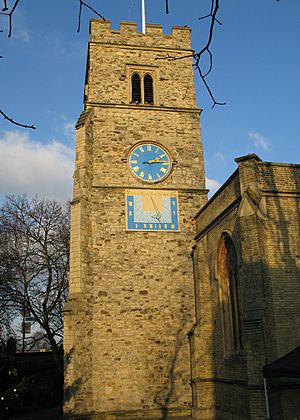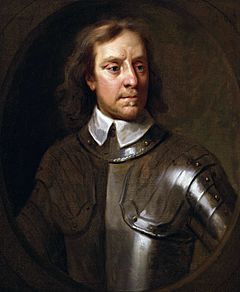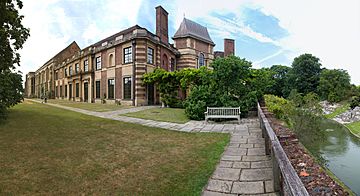Nathaniel Rich (soldier) facts for kids
Quick facts for kids
Nathaniel Rich
|
|
|---|---|

St. Mary's Church, Putney, location of the 1647 Putney Debates; Rich was a leading participant
|
|
| Captain of Deal Castle | |
| In office 1648–1653 |
|
| Member of Parliament for Cirencester |
|
| In office February 1648 – March 1660 |
|
| Personal details | |
| Born | c. 1622 Felsted, Essex |
| Died | 1701 to 1702, age 79 (approximate) Stondon Massey, Essex |
| Nationality | English |
| Spouses | (1) Elizabeth Hampden (1644–1655 her death) (2) Lady Elizabeth Kerr (1663–his death) |
| Children | Nathaniel (before 1648, after 1702); Robert (ca.1648–1699); unnamed daughter |
| Alma mater | St Catharine's College, Cambridge; Gray's Inn |
| Occupation | Puritan radical and soldier |
| Military service | |
| Allegiance | Parliamentarians |
| Rank | Colonel |
| Battles/wars | |
Colonel Nathaniel Rich (born around 1620–1622, died 1701–1702) was an important figure from Essex, England. He came from a wealthy family who owned land. During the Wars of the Three Kingdoms, he supported the Parliament against the King. He was known as a "pious Puritan gentleman" who believed in the ideas of the English Revolution.
In 1645, Rich became a colonel in the New Model Army, which was Parliament's main army. In 1648, he was elected as a MP for Cirencester. He was very close to Oliver Cromwell, a powerful leader, for a while. However, they disagreed when Rich joined the Fifth Monarchists. This was a radical religious group that did not want Cromwell to become Lord Protector (a powerful ruler) in 1653.
Because of this disagreement, Rich was removed from the army and lost much of his power. But he still believed in a republic (a country without a king). He opposed the Stuart Restoration in May 1660, which brought the King back to power. Since he had not taken part in the execution of King Charles I, he was pardoned. This meant he wasn't punished under the Indemnity and Oblivion Act.
However, in January 1661, he was arrested during a short uprising led by another Fifth Monarchist, Thomas Venner. Rich was released in 1665 and lived quietly on his estate in Essex until his death. He was one of the few senior officers from the New Model Army to live into the 18th century.
Contents
Early Life and Family
Nathaniel Rich was born in Felsted, Essex, England. He was the oldest son of Robert Rich and Elizabeth Dutton. We don't know his exact birth date, but it was likely between 1620 and 1622. He was part of the well-known Rich family. He was related to Robert Rich, 2nd Earl of Warwick, who led Parliament's navy from 1643 to 1649. He was also related to Warwick's younger brother, Henry Rich, 1st Earl of Holland, who was executed by Parliament in 1649.
In January 1644, Nathaniel married Elizabeth (born around 1625, died 1655). She was the daughter of Sir Edmund Hampden and a cousin of John Hampden, a Parliamentarian leader who died in 1643. Nathaniel and Elizabeth had three children: Nathaniel (born before 1648, died after 1702), Robert (born around 1648, died 1699), and a daughter whose name is not known.
In 1663, he married Lady Elizabeth Kerr as his second wife. They did not have any children. When he died, his will stated that she could live on his lands for the rest of her life. After her death, the lands would go to his son Nathaniel. His younger son, Robert, married a distant cousin named Mary Rich. In 1677, Robert inherited the title and lands of his father-in-law, Sir Charles Rich.
Joining the War for Parliament

Nathaniel's father died when he was young. In 1636, Rich inherited the manor of Stondon Massey in Essex from his uncle, Sir Nathaniel Rich. He went to Felsted School, where four of Oliver Cromwell's sons also studied. His teacher was Samuel Wharton, a "godly" minister chosen by the very religious Earl of Warwick.
In 1637, he finished his studies at St Catharine's College, Cambridge. This college was known for its Puritan teachings. In August 1639, he began training to be a lawyer in London at Gray's Inn.
With this background, it was natural for him to support Parliament when the First English Civil War began in August 1642. The Earl of Essex was made the commander of Parliament's army. Rich joined his personal guard unit, which was made up of other lawyers. This unit fought in early battles like Powick Bridge in September and Edgehill in October 1642.
In 1643, he moved to the army of the Eastern Association. He became a captain of a cavalry troop in the Earl of Manchester's regiment. By July 1644, when his unit fought in the important Battle of Marston Moor, he had become a lieutenant-colonel.
After the battles of Marston Moor and Second Battle of Newbury in October 1644, there were arguments about why Parliament didn't win more decisively. Rich was one of the people Cromwell relied on to criticize Manchester and Essex. This led to their removal from command. In February 1645, Rich was promoted to colonel, and his regiment joined the New Model Army.
His appointment was first rejected by the House of Commons, but he was confirmed in time to fight at Naseby in June. Rich then took part in many battles from 1645 to 1646 that helped Parliament gain control of South West England. This region's loss severely weakened the King's army. When the war ended with the Third Siege of Oxford in June 1646, Sir Thomas Fairfax chose Rich to help negotiate its surrender. In 1647, Rich and Fairfax were elected as MPs for Cirencester. However, they didn't officially start their roles until February 1649.
After Parliament's victory, there was a struggle for power between the army and Parliament. Rich was first seen as a moderate. He discouraged soldiers from sending petitions (requests) to Parliament. However, when Parliament tried to break up the New Model Army without paying the soldiers what they were owed, Rich supported his regiment's refusal to obey. He also helped write the "Heads of Proposals," which listed the army's conditions for peace with King Charles I.
These proposals were mostly written by senior officers. But the soldiers' representatives, called "Agitators," said they weren't enough. This led to the Putney Debates in October-November 1647, where both sides tried to agree. Rich was an important part of these talks. Like most senior officers, he was against the Agitators' demand for "One man, one vote" (everyone having an equal vote).
After some unrest in London, Rich's regiment was based in the Royal Mews in January 1648 to guard Parliament. In April, they put down a riot that supported the King, just after the Second English Civil War began. On June 1, he joined Fairfax's army sent to stop an uprising in Kent. He helped storm the town of Maidstone.
He was then sent to help the port of Dover. After that, he recaptured Walmer Castle, Deal, and Sandown Castle from the Royalists. He did this very efficiently by the end of August. After Deal Castle was taken back, he was made its Governor, or Captain of Deal Castle. He held this position until 1653.
Life After the King's Execution
After the King's defeat in the Second Civil War, attitudes became harsher. Many, including Cromwell, decided that talking with Charles was useless and he had to be removed. In December 1648, "Pride's Purge" removed MPs who opposed the army. This created a smaller Parliament of 210 members, called the Rump Parliament. Most of these members wanted to put the King on trial.
Rich supported the creation of the Commonwealth of England (a republic). However, he doubted if the High Court of Justice for the trial of Charles I was legal. He refused to be a judge in the King's trial. He didn't take his seat in Parliament until February 1649, after the King's execution in January.

Even though he didn't actively participate in the King's trial and execution, Rich remained loyal to Cromwell. In December 1650, he put down an uprising by Royalists in Norfolk. He benefited from his new status by gaining lands that had been taken from the Crown. These lands were near Eltham Palace in Kent and High Easter in Essex. He also played an important role in supporting the army in Parliament.
However, the Rump Parliament became more and more against the new government. They objected to the cost of the New Model Army and the First Anglo-Dutch War. This led Cromwell to dismiss Parliament in April 1653. Rich, like other Fifth Monarchists such as Major Generals Thomas Harrison and Robert Overton, supported replacing it with the "Barebones Parliament" in July 1653. But he broke with Cromwell when Cromwell dissolved this body in December and became Lord Protector.
Rich and several officers from his regiment were linked to the "Petition of the three colonels." This document was shared widely in the New Model Army and criticized Cromwell for taking power. Rich was dismissed from the army in 1654. In 1655, he was arrested and brought before the English Council of State. This was because he said Cromwell's government was not legal and that people had the right to fight against it.
He was released in early 1656. He was among the MPs who were not allowed to join the Second Protectorate Parliament in July 1656. Some people thought he was a serious threat to the government. This was because of his military connections and the influence of the Rich family in Essex and Suffolk. Several MPs who were allowed to join Parliament were connected to him or his relative, the Earl of Warwick.
Cromwell died in September 1658, and his son Richard took over. This led to a power struggle between the army and the Third Protectorate Parliament. This Parliament was mostly made up of people who secretly supported the King or moderate Presbyterians. In April 1659, a group of senior officers forced Richard Cromwell to resign. They brought back the remaining members of the Rump Parliament.
Rich was among them. He was made colonel of his regiment again and offered the job of Ambassador to the Dutch Republic, but he refused. As political chaos continued into 1660, the military commander in Scotland, General George Monck, marched his troops into England in February. He forced Parliament to bring back the MPs who had been removed in 1648.
Realizing Monck wanted to bring back the monarchy, Rich supported John Lambert's attempt to keep the Commonwealth by force. However, Rich's troops refused to follow him. Sir Richard Ingoldsby was made colonel instead, and Rich was arrested.
After the Monarchy Returned
After the Stuart Restoration in May 1660, Rich lost the lands he had gained in Eltham and High Easter. But since he was not one of the regicides (people who signed the King's death warrant), he was released under the Indemnity and Oblivion Act.
Despite this, he was arrested again on January 10, 1661. This happened during a short uprising led by his fellow Fifth Monarchist, Thomas Venner. Rich was held in Portsmouth. In August 1663, he married Lady Elizabeth Kerr, daughter of the Earl of Ancram. Thanks to her efforts and the support of his jailer, Charles Berkeley, 1st Earl of Falmouth, he was finally set free in 1665. He spent the rest of his life living quietly in Stondon. He died sometime between October 1700, when he wrote his will, and March 1702, when it was officially approved.
Images for kids
-
St. Mary's Church, Putney, location of the 1647 Putney Debates; Rich was a leading participant


